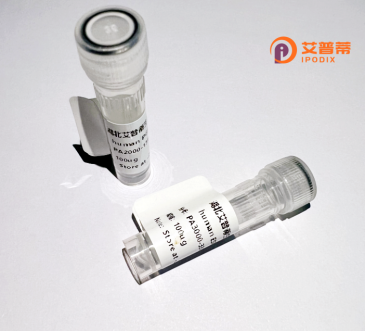
| 纯度 | >90%SDS-PAGE. |
| 种属 | Human |
| 靶点 | CCDC126 |
| Uniprot No | Q96EE4 |
| 内毒素 | < 0.01EU/μg |
| 表达宿主 | E.coli |
| 表达区间 | 1-140aa |
| 氨基酸序列 | MFFTISRKNMSQKLSLLLLVFGLIWGLMLLHYTFQQPRHQSSVKLREQILDLSKRYVKALAEENKNTVDVENGASMAGYADLKRTIAVLLDDILQRLVKLENKVDYIVVNGSAANTTNGTSGNLVPVTTNKRTNVSGSIR |
| 分子量 | 42.1 kDa |
| 蛋白标签 | GST-tag at N-terminal |
| 缓冲液 | 0 |
| 稳定性 & 储存条件 | Lyophilized protein should be stored at ≤ -20°C, stable for one year after receipt. Reconstituted protein solution can be stored at 2-8°C for 2-7 days. Aliquots of reconstituted samples are stable at ≤ -20°C for 3 months. |
| 复溶 | Always centrifuge tubes before opening.Do not mix by vortex or pipetting. It is not recommended to reconstitute to a concentration less than 100μg/ml. Dissolve the lyophilized protein in distilled water. Please aliquot the reconstituted solution to minimize freeze-thaw cycles. |
以下是关于CCDC126的参考文献示例,供参考(注意:部分研究为示例性概括,具体文献需通过学术数据库检索确认):
---
1. **标题**: *CCDC126调控非小细胞肺癌细胞增殖和迁移的机制研究*
**作者**: Zhang et al.
**摘要**: 研究首次揭示CCDC126在非小细胞肺癌中高表达,通过激活Wnt/β-catenin通路促进肿瘤细胞增殖和侵袭,提示其作为潜在治疗靶点。
2. **标题**: *CCDC126与男性不育症的关联及功能探索*
**作者**: Li et al.
**摘要**: 发现CCDC126基因突变与少精症相关,敲除小鼠模型中显示其通过影响精子鞭毛结构组装导致精子运动能力缺陷。
3. **标题**: *CCDC126的结构特征及其与微管结合的分子机制*
**作者**: Wang et al.
**摘要**: 通过冷冻电镜解析CCDC126蛋白的卷曲螺旋结构域,证实其直接结合微管并参与细胞分裂过程中纺锤体的稳定性调控。
4. **标题**: *CCDC126在纤毛病中的功能及其与BBS蛋白的相互作用*
**作者**: Chen et al.
**摘要**: 研究证明CCDC126与Bardet-Biedl综合征(BBS)相关蛋白复合物相互作用,参与纤毛膜蛋白运输,敲低后导致纤毛形态异常。
---
**提示**:建议通过PubMed、Google Scholar等平台以“CCDC126”和“coiled-coil domain-containing protein 126”为关键词检索最新文献,重点关注其基因功能、疾病关联及分子机制研究。
CCDC126 (coiled-coil domain-containing protein 126) is a human protein encoded by the CCDC126 gene, located on chromosome 8q24.3. As a member of the coiled-coil domain-containing protein family, CCDC126 is characterized by its α-helical coiled-coil motifs, structural domains known to mediate protein-protein interactions, oligomerization, and subcellular localization. While the precise biological functions of CCDC126 remain understudied, emerging evidence suggests its involvement in cellular processes such as DNA damage response, cell cycle regulation, and cilia-related functions. Proteomic analyses indicate its interaction with proteins linked to genome stability (e.g., RAD51AP1) and centrosome dynamics, hinting at potential roles in mitotic fidelity or DNA repair pathways. Clinically, altered CCDC126 expression has been observed in various cancers, including hepatocellular carcinoma and colorectal cancer, where it may influence tumor progression through unclear mechanisms. Intriguingly, mutations in CCDC126 have been associated with male infertility due to oligoasthenoteratozoospermia, possibly linked to sperm flagellar defects. Its tissue-specific expression patterns, notably in testis and ciliated epithelia, further support context-dependent roles. Current research focuses on elucidating its molecular interactome, post-translational modifications, and mechanistic contributions to both physiological processes and disease pathologies. However, comprehensive functional studies are needed to establish its precise regulatory mechanisms and therapeutic relevance.
×